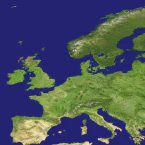Revealing Europes Hidden Gems for Travelers

Discover Europe’s Hidden Gems: Alternative Cities to Beat the Crowds
Do you hate crowds? Are you looking for an authentic European experience without being swarmed by tourists? Look no further, as we bring you a list of amazing cities in Europe that offer rewarding alternatives to the continent’s most popular tourist destinations. So pack your bags, and let’s explore these lesser-known gems together!
Valencia, Spain: A Charming Escape from Barcelona’s Bustle
Barcelona has long been Spain’s go-to tourist destination, but with around 30 million annual visitors, it’s time to look for an alternative. Just down the road, you’ll find Valencia, Spain’s third-largest city, with a rich blend of Romanesque, Renaissance, and modern architecture. Home to UNESCO World Heritage sites like Yoda de la Ceda and unspoiled beaches such as La Marvarosa, Valencia offers some of the best cuisine on the continent. With only 2 million visitors per year, it’s the perfect destination to experience Spain’s wonders without the hassle of the crowds.
Coteur, Montenegro: The Adriatic’s Hidden Treasure
Dubrovnik has been struggling with overcrowding, prompting the city to launch the Respect the City campaign in 2019. If you’re planning a trip to the Adriatic in the Balkans, consider the Montenegrin city of Coteur instead. Similar to Dubrovnik, Coteur is a walled city built by the Venetians in the 15th century, boasting UNESCO World Heritage status. Discover its cobblestone streets, the centuries-old Cathedral of Saint Trifon, and the dramatic Saint John’s fortress, all without battling selfie-seeking hordes.
Lucca, Italy: A Quieter, More Authentic Taste of Tuscany
Florence may be Italy’s hub for all things Renaissance, but its popularity has led to overtourism. For a quieter experience, head to Lucca, just an hour’s drive west of Florence. This Tuscan secret offers a serene setting to enjoy Renaissance art, architecture, history, and culture. Stroll along Lucca’s ring of fortifications, now a public park, and indulge in the city’s culinary scene, hailed as the best in Tuscany.
Tinos, Greece: A Tranquil Island Paradise
Santorini’s allure has made it a victim of its own success, with cruise ship passengers and Instagrammers flooding the island. For a more authentic and uncrowded experience, sail to the municipality of Tinos, home to beautiful sunsets, quiet villages, and dreamy landscapes. The island’s beaches are beautiful, plentiful, and surprisingly peaceful – a true Greek paradise.
Olymots, Czech Republic: A Fairytale City with a Modern Twist
Prague has become one of Europe’s hottest tourist destinations, but Olymots offers a charming alternative with a blend of old-world charm and modern attractions. Explore Olymots on foot, stopping at the Olymots Archdiocesan Museum and the Holy Trinity Column. Grab a drink at Maznikramé, a former meat market, or dine at Hanaka Hospoda for a traditional Czech meal.
Delft and The Hog, The Netherlands: Two Dutch Delights
Overcrowding in Amsterdam has become so severe that the country’s tourism board is no longer promoting it. Instead, visit Delft and The Hog, two quieter alternatives that are only about five miles apart. Both cities offer a glimpse into Dutch history, with The Hog being home to the UN’s International Court
of Justice and the Dutch government. Delft’s picturesque canals are perfect for leisurely exploration, free from the chaos of Amsterdam’s tour boats.
Delft is also the birthplace of celebrated Dutch painter Johannes Vermeer and boasts numerous art galleries and museums, such as the Museum Prinsenhof Delft. The Hog features the Mauritshuis and the Gemeentemuseum Den Haag, both housing famous works of art.
If you’re looking for a party, head to one of the many beach bars in Scheveningen. These Dutch cities offer a refreshing alternative to Amsterdam’s crowded streets, allowing you to fully immerse yourself in the Netherlands’ unique culture.
With these incredible alternatives to Europe’s popular tourist destinations, you can explore the continent’s rich history, culture, and beauty without being overwhelmed by crowds. So why not venture off the beaten path and discover the hidden gems Europe has to offer? You might just find your new favorite city or island getaway.
Conclusion
In summary, Europe offers a plethora of lesser-known destinations that provide equally rich and memorable experiences as their more popular counterparts. By opting to explore these hidden gems, travelers can not only avoid the challenges of overtourism but also enjoy a more authentic and intimate connection with the local culture, history, and natural beauty. These remarkable cities and islands – Valencia, Coteur, Lucca, Tinos, Olymots, Delft, and The Hog – are true testaments to Europe’s diverse and vibrant tapestry.
Taking the road less traveled can lead to serendipitous discoveries and create lifelong memories, as these destinations offer unique perspectives and experiences that often go overlooked by the masses. So, whether you’re a seasoned traveler or planning your first European adventure, consider venturing off the beaten path and immersing yourself in the hidden wonders that this enchanting continent has to offer. As you explore these captivating alternatives, you may well find yourself falling in love with Europe all over again, revealing its endless surprises and cherishing the genuine connections formed along the way.
What is the best time to visit these lesser-known European destinations?
The ideal time to visit these hidden gems in Europe largely depends on your preferences and the specific destination. Generally, spring (April to June) and autumn (September to October) offer pleasant weather and fewer crowds, making them great times to explore these alternative cities and islands.
How can I travel responsibly and sustainably in these lesser-known cities?
Traveling responsibly and sustainably involves being mindful of your impact on the local environment, culture, and economy. Choose locally-owned accommodations, eat at local restaurants, and support small businesses by purchasing souvenirs from artisanal shops. Be respectful of local customs, and always follow guidelines for responsible waste disposal and water usage.
Are these alternative destinations suitable for families with children?
Yes, these alternative European destinations are suitable for families with children. These cities and islands offer a variety of activities, attractions, and experiences that cater to all age groups. Moreover, the less crowded nature of these locations allows for a more relaxed and enjoyable family vacation.
Do I need to learn the local language when visiting these lesser-known destinations?
While it is not mandatory to learn the local language when visiting these destinations, having some basic knowledge of key phrases and greetings can greatly enhance your travel experience. Locals appreciate when travelers make an effort to communicate in their language, and it can lead to more meaningful interactions and a deeper understanding of the culture.
How can I ensure my safety while traveling to these lesser-known European cities and islands?
To ensure your safety while traveling to these destinations, follow general travel safety guidelines, such as staying informed about local news and updates, keeping your belongings secure, and being aware of your surroundings. Additionally, it’s a good idea to share your itinerary with a trusted friend or family member back home, and always have a backup plan in case of emergencies.





